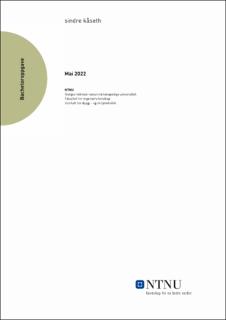| dc.contributor.advisor | Narum, Eskild Bakken | |
| dc.contributor.author | Kpåseth, Sindre | |
| dc.date.accessioned | 2022-07-23T17:19:39Z | |
| dc.date.available | 2022-07-23T17:19:39Z | |
| dc.date.issued | 2022 | |
| dc.identifier | no.ntnu:inspera:106258180:112687866 | |
| dc.identifier.uri | https://hdl.handle.net/11250/3007987 | |
| dc.description.abstract | Oppgaven er en teoristudie kombinert med en praktisk studie som undersøker muligheten for ombruk av håndlaftede bygg, og ser dette i lys av ønsket og behov for økt ombruk og sirkularitet i byggebransjen. Studien vinkles spesifikt inn mot de eldre, håndlaftede byggene i Norge som står overflødige. Fem potensielle ombruksbygg i denne kategorien har blitt systematisk undersøkt med målinger og variabler valgt ut på grunnlag av funn gjennom teoristudien. Ekstern kompetanse har også blitt kontaktet da det viste seg å være mangelfull informasjon tilgjengelig.
Oppgaven har følgende problemstilling: Hvordan kan et laftebygg ombrukes til boligformål, og slik bidra til en mer sirkulær byggebransje?
Problemstillingen er todelt; Første del går direkte på hvordan et håndlaftet bygg kan ombrukes sett gjennom gjeldene regelverk og forskrifter. Andre del forsøker å finne ut hvordan dette kan bidra til klimabesparelser og en mer sirkulær byggebransje. I studien anvendes en kombinasjon av kvalitativ og kvantitativ metode, også kalt mixed method for å best mulig tilnærme seg et svar på den todelte problemstillingen.
Bakgrunnen for studien er økt søkelys og ønske om mer ombruk i byggebransjen. Det viser seg allikevel at det er utfordrende i praksis på grunn av kompliserte dokumentasjon og tekniske krav som ikke er tilpasset ombruk . Gjennom teoristudien er det innhentet informasjon som viser at håndlaftede bygg kan være enklere å dokumentere i et ombrukscenario. Resultater og funn fra studien viser at det kan være et betydelig omfang og potensiale for ombruk av håndlaftede bygninger i Norge. Dette vil kunne gi reduserte klimagassutslipp og bidra til en mer sirkulær byggebransje. | |
| dc.description.abstract | This thesis is a theory study combined with a practical study that examines the possibility of reusing hand-made buildings, and sees this in light of the desire and need for increased reuse and circularity in the construction industry. The study is specifically angled towards the older, hand-built buildings in Norway that are redundant. Five potential reuse buildings in this category have been systematically investigated with measurements and variables selected on the basis of findings through the theory study. External expertise has also been contacted as it turned out that there was a lack of information available.
The thesis has the following problem: How can a log building be reused for residential purposes, and thus contribute to a more circular construction industry?
The problem is twofold; The first part deals directly with how a hand-made building can be reused seen through the current regulations and regulations. The second part tries to find out how this can contribute to climate savings and a more circular construction industry.
The study uses a combination of qualitative and quantitative methods, also called mixed methods, in order to best approach an answer to the two-part problem.
The background for the study is increased focus and desire for more reuse in the construction industry. It still turns out that it is challenging in practice due to complicated documentation and technical requirements that are not adapted to reuse.
Through the theory study, information has been obtained that shows that hand-made buildings can be easier to document in a reuse scenario. Results and findings from the study show that there may be a significant scope and potential for reuse of hand-built buildings in Norway. This could reduce greenhouse gas emissions and contribute to a more circular construction industry. | |
| dc.language | nob | |
| dc.publisher | NTNU | |
| dc.title | Ombruk av håndlaftede bygninger til boligformål | |
| dc.type | Bachelor thesis | |
